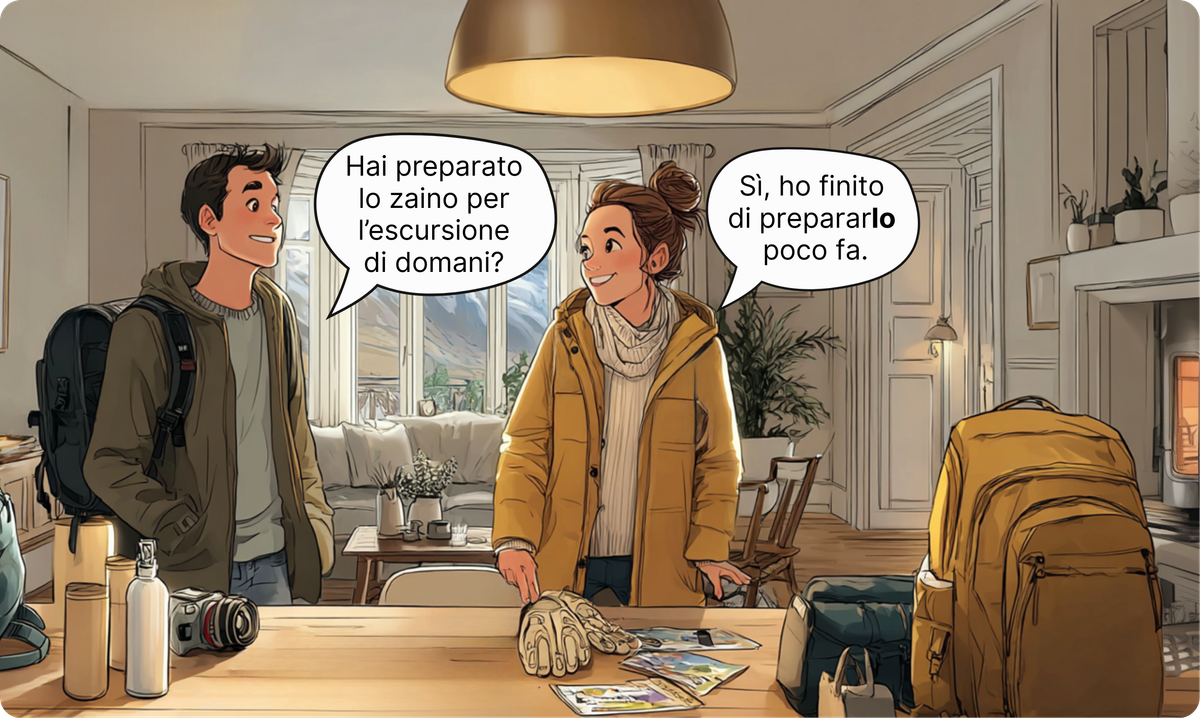Intro.
In the Italian language, pronouns are fundamental tools for avoiding repetitions and making communication clearer and more fluid. There are different categories of pronouns, each with a specific function: personal, direct, indirect, reflexive, combined, just to name a few. Each of these helps simplify sentences by replacing elements that are already known or easily understood from context.
This guide focuses specifically on direct pronouns, among the most used in daily communication. You'll learn to recognize them, understand what forms they take, and discover when and how to use them. Direct pronouns have the job of replacing the direct object of the verb, that is, the person or thing that directly receives the action expressed by the verb. Using them correctly allows you to avoid repetitions, lighten sentences, and make Italian more natural and flowing, like that of native speakers.
By the end of this guide, you'll know what a direct pronoun is, how to identify it, where to place it within a sentence, and which verbs it's most frequently used with. Your Italian will be more fluent, spontaneous, and precise.
1. Italian Direct Pronouns
Direct pronouns are words that replace the direct object of the verb, that is, the person, animal, or thing upon which the action expressed by the verb falls. They perform the function of direct object and are used with verbs that answer the questions "Chi?" (Who?), "Che cosa?" (What?).
Consider the sentence:
Preparo il pacco, porto il pacco alla posta e spedisco il pacco.
I prepare the package, I take the package to the post office, and I send the package.
Il "pacco" (the package) is the direct object of the verbs preparare (to prepare), portare (to take/carry), and spedire (to send). To avoid repeating the noun "pacco", we use a direct pronoun in the second and third parts of the sentence. In all three cases, the package answers the question Che cosa? (What?): prepare/take/send what? The package.
Direct pronouns correspond to subject personal pronouns in this way:
| Subject Pronoun | Direct Pronoun |
|---|---|
| Io | mi |
| Tu | ti |
| Lui/lei | lo/la (La) |
| Noi | ci |
| Voi | vi |
| Loro | li/le |
Direct pronouns in this form are called atoni (unstressed) and are used most frequently. They are invariable and are never preceded by a preposition.
The pronouns mi, ti, ci, vi agree in number with the noun they replace; the direct pronouns lo, la, li, le agree in gender (masculine or feminine) and number (singular or plural) with the noun they replace:
- mi and ti for masculine and feminine singular;
- ci and vi for masculine and feminine plural;
- lo for masculine singular;
- la for feminine singular;
- li for masculine plural;
- le for feminine plural.
Example:
Vedo Monica ogni giorno.
I see Monica every day.
Vedo chi? ogni giorno → Monica
I see who? every day → Monica
In this sentence, Monica is the direct object of the verb vedere (to see). The name Monica can be replaced by the feminine singular direct pronoun la:
Example:
La vedo.
I see her.
Direct pronouns are used in this way:
• the direct pronouns mi, ti, ci, vi replace names of people;
Example:
Sono davanti al cinema. Mi vedi?
Sì, ti vedo!
I'm in front of the cinema. Do you see me?
Yes, I see you!
• the direct pronouns lo, la, li, le replace people, things, and animals;
Examples:
Chiami Egidio per favore?
Sì, lo chiamo tra poco. (lo = Egidio → persona)
Can you call Egidio please?
Yes, I'll call him shortly. (lo = Egidio → person)
Vuoi la torta di noci?
Sì, la voglio. (la = la torta → cosa)
Do you want the walnut cake?
Yes, I want it. (la = the cake → thing)
Hai portato i gatti dal veterinario?
Li porto più tardi. (Li = i gatti → animali)
Did you take the cats to the veterinarian?
I'll take them later. (Li = the cats → animals)
• the pronouns lo and la lose their vowel and become l' before words that begin with a vowel or in compound tenses before the auxiliary avere. The pronouns li and le, instead, don't lose their final vowel;
Examples:
Ascolti musica rock?
No, non l’ascolto mai.
Do you listen to rock music?
No, I never listen to it.
Avvisi tu le tue sorelle, per favore?
Sì, le avviso io.
Will you notify your sisters, please?
Yes, I'll notify them.
Questo orologio l’ho comprato un anno fa.
I bought this watch a year ago.
Dove hai lasciato le chiavi?
Le ho lasciate sopra al tavolo.
Where did you leave the keys?
I left them on the table.
• the pronoun lo can also replace entire sentences;
Example:
Sai che Lorenzo ha vinto il concorso?
Sì, lo so. (lo = che Lorenzo ha vinto il concorso)
Do you know that Lorenzo won the competition?
Yes, I know it. (lo = that Lorenzo won the contest)
• if a direct pronoun replaces two nouns of different genders, the masculine plural pronoun li is used;
Example:
Hai visto Marco e Marzia?
Sì, li ho visti ieri. (li = Marco e Marzia)
Did you see Marco and Marzia?
Yes, I saw them yesterday. (li = Marco and Marzia)
• for the formal singular form, the pronoun La is used for both masculine and feminine; for the formal plural form, Vi is used.
Example:
Signor Foci, La ringrazio per l’aiuto.
Mr. Foci, I thank you for your help.
Signori Conti, Vi chiamo domani.
Mr. and Mrs. Conti, I’ll call you tomorrow.
2. Direct Pronouns with Compound Tenses
When direct pronouns come before a compound tense like the passato prossimo, the past participle changes in this way:
• with the direct pronouns lo, la, li, le the past participle agrees in gender and number with the direct pronoun and ends with the vowels -o, -a, -i, -e;
Examples:
Hai comprato la borsa che ti avevo consigliato?
Sì, l’ho comprata ieri.
Did you buy the bag I recommended to you?
Yes, I bought it yesterday.
Hai letto gli articoli che ti ho inviato?
No, non li ho ancora letti.
Have you read the articles that I sent you?
No, I haven't read them yet.
• with the direct pronouns mi, ti, ci, vi, agreement between the direct pronouns and the past participle is not mandatory.
Example:
Abbiamo incontrato Gennaro e non ci ha salutati / non ci ha salutato.
We met Gennaro and he didn't greet us.
3. The Position of Direct Pronouns
In Italian, the position of direct pronouns within a sentence changes depending on the verb form.
As a general rule, direct pronouns come before conjugated verbs; they follow and unite with imperative verbs and indefinite forms.
3.1 The Position of Direct Pronouns with Verbs in Simple and Compound Tenses
Unstressed direct pronouns mi, ti, lo/la, ci, vi, li/le precede verbs in sentences with simple tenses like the present and in compound tenses like the passato prossimo.
Examples:
Mangio il cioccolato. → Lo mangio.
I eat the chocolate. → I eat it.
Indosseresti questa giacca?
No, non la indosserei mai.
Would you wear this jacket?
No, I would never wear it.
Hai mangiato la frutta?
Sì, l’ho mangiata.
Did you eat the fruit?
Yes, I ate it.
Hai visto il documentario sulle civiltà antiche?
Purtroppo no, ma l’avrei visto volentieri.
Have you seen the documentary on ancient civilizations?
Unfortunately no, but I would have gladly watched it.
3.2 Direct Pronouns with Modal Verbs dovere, potere, and volere or Other Verbs Followed by an Infinitive
Direct pronouns with modal verbs dovere (to have to/must), potere (to be able to/can), and volere (to want):
• Direct pronouns are found either before the modal verb or united to the infinitive.
Example:
Emiliano è stanchissimo. Lo devo assolutamente aiutare.
Emiliano is extremely tired. I absolutely must help him.
Questo film è noioso. Non voglio guardarlo.
This movie is boring. I don't want to watch it.
The two forms are equivalent and can be used interchangeably in the sentence without generating any change in meaning.
Example:
Oggi c’è l’ultima puntata della mia serie TV preferita, ma non la posso vedere.
Oggi c’è l’ultima puntata della mia serie TV preferita, ma non posso vederla.
Today there's the last episode of my favorite TV series, but I can't watch it.
• With modal verbs in compound tenses, the agreement of the participle changes based on the position of the pronoun: when the pronoun precedes the verbs, the participle agrees with the pronoun; when pronouns unite with the infinitive, the participle remains unchanged.
Example:
Hai letto le note che ha scritto Giovanna?
No, non le ho potute leggere.
Sì, ho dovuto leggerle attentamente.
Did you read the notes that Giovanna wrote?
No, I couldn't read them.
Yes, I had to read them carefully.
Direct pronouns with other verbs followed by an infinitive:
• In simple tenses, like present or future, direct pronouns are found before or after the verb, even with some particular constructions followed by the infinitive like cominciare a (to start to), stare per (to be about to), finire di (to finish).
In both cases, it's more frequent to unite the pronouns to the infinitive.
Example:
(Io) Ti vengo a trovare. ↔ (Io) Vengo a trovarti.
I come to visit you.
Lo comincio a leggere (il libro). ↔ Comincio a leggerlo.
I'm starting to read it (the book).
• In compound tenses with essere (to be), the past participle remains unchanged and agrees with the subject of the sentence. The direct pronoun unites with the infinitive.
In compound tenses with avere (to have), the past participle agrees with the direct pronoun if the direct pronoun precedes the verbs; the participle remains unchanged when the direct pronoun unites with the infinitive. In both cases, it's more frequent to unite the pronouns to the infinitive.
Examples:
(Noi) Siamo andate a cercarlo. ↔ (Noi) Lo siamo andate a cercare.
We went to look for him/it.
Ho cominciato a scriverle (le lettere). ↔ Le ho cominciate a scrivere (le lettere).
I started to write them (the letters).
• Direct pronouns are found before verbs in the construction of fare (to make/have done) and lasciare (to let/allow) followed by the infinitive in both simple and compound tenses.
Examples:
Lo faccio disegnare (un progetto).
I’ll have it designed (a project).
Li ho lasciati parlare.
I let them talk.
3.3 The Position of Direct Pronouns with the Imperative
• Direct pronouns are found after and united to verbs in informal imperative forms (imperative with "tu");
Example:
È uno spettacolo bellissimo! Guardalo!
It's a beautiful show! Look at it!
The verbs dire (to say), dare (to give), fare (to do/make) double the consonant of the direct pronoun in the second person singular when used in the truncated forms of the direct imperative:
- dire → di' → dillo (say it);
- dare → da' → dallo (give it);
- fare → fa' → fallo (do it).
• With the negative imperative expressed by non + infinitive, pronouns can precede or follow the infinitive (the pronoun unites with the infinitive which loses its final vowel). The two forms are equivalent and can be used interchangeably in the sentence without generating any change in meaning.
Example:
Non lo guardare! ↔ Non guardarlo!
Don't look at it! ↔ Don't look at it!
3.4 The Position of Direct Pronouns with Indefinite Moods
• Direct pronouns unite with the present infinitive and present gerund with which they form a single word (the infinitive loses its final vowel).
Examples:
Hai fatto bene a leggerla (la Divina Commedia).
You did well to read it (the Divine Comedy).
Leggerla è frequente nelle scuole (la Divina Commedia).
Reading it is common in schools (the Divine Comedy).
Puoi imparare una poesia a memoria, ripetendola molte volte.
You can learn a poem by heart by repeating it many times.
• With verbs in the past infinitive and past gerund like avere mangiato (to have eaten) or avendo mangiato (having eaten), the direct pronoun unites with the auxiliary avere (to have). In the past infinitive, the auxiliary avere loses its final vowel -e as in the forms avermi (to have me), averti (to have you), averlo (to have him/it), etc.; in the past gerund, the pronoun is simply added to avendo (having) as in the forms avendomi (having me), avendoti (having you), avendolo/le (having him/her/it/them), etc.
Examples:
Sono molto contenta di averti visto!
I'm very happy to have seen you!
Avendolo conosciuto meglio, ho cambiato opinione su Giacomo.
Having gotten to know him better, I changed my opinion about Giacomo.
3.5 The Position of Pronouns with the Adverb ecco
Direct pronouns are found after the adverb ecco, forming a single word.
Example:
Ecco Marilena! → Eccola!
There's Marilena! → There she is!
4. Stressed Direct Pronouns
Alongside the unstressed form, direct pronouns also have a forma tonica (stressed form). They are always found after the verb as independent words. They mainly replace people.
Stressed direct pronouns are used to give particular emphasis to the pronoun, often with a value of contrast to another pronoun or noun.
In the stressed form, direct pronouns change only in the first and second person singular; for all other persons, the same forms as subject personal pronouns are used:
| Subject Pronoun | Direct Pronouns |
|---|---|
| io | me |
| tu | te |
| lui/lei | lui/lei |
| noi | noi |
| voi | voi |
| loro | loro |
Examples:
Stefano cerca me, non te.
Stefano is looking for me, not you.
Aspettiamo voi, non loro.
We are waiting for you, not them.
Mi ascolti? Guarda me, non la televisione, mentre ti parlo!
Are you listening to me? Look at me, not the television, while I’m talking to you!
Stressed pronouns are also used in some constructions:
• after come (like) and quanto (as much as/how much);
Examples:
Sei come me!
You are like me!
Non sono bravo quanto te!
I'm not as good as you!
• in exclamatory forms povero me!, beato te!
Examples:
Ho perso di nuovo l’autobus. Povero me!
I missed the bus again. Poor me!
Hai già finito i compiti? Beato te!
You've already finished your homework? Lucky you!
Sometimes stressed pronouns are followed by stesso (same/self) which reinforces the pronoun:
Examples:
Consideri solo te stesso!
You only consider yourself!
5. How to Use Direct Pronouns
To understand how to use direct pronouns, you must consider the verb. In Italian, there are verbs that are used only with direct pronouns. These verbs take a direct object and answer the questions Chi? (Who?), Che cosa? (What?).
These are verbs like: aiutare (to help), amare (to love), aspettare (to wait for), bere (to drink), baciare (to kiss), conoscere (to know), comprare (to buy), leggere (to read), mangiare (to eat), guardare (to watch/look at), vedere (to see), ascoltare (to listen to), sentire (to hear/feel).
Examples:
Aiuti tu Livio con i compiti? (chi aiuti? → Livio)
Certo, lo aiuto volentieri!
Are you helping Livio with his homework? (who are you helping? → Livio)
Of course, I'm happy to help him!
Leggi spesso i giornali? (che cosa leggi? → i giornali)
Sì, li leggo quasi tutti i giorni.
Do you often read newspapers? (what do you read? → newspapers)
Yes, I read them almost every day.
Hai visto la mostra di arte moderna? (cosa hai visto? → la mostra)
Sì, l’ho vista ieri pomeriggio.
Did you see the modern art exhibition? (what did you see? → the exhibition)
Yes, I saw it yesterday afternoon.
6. Direct Pronouns in Context: Italian Short Story
This short story demonstrates how direct pronouns work naturally within Italian conversation, showing the interplay between different pronoun forms, verb constructions, and everyday communication to create a complete picture of how Italians use these grammatical elements in real-life situations.

Luca: Allora, domani mattina partiamo presto per l'escursione in montagna. Hai già preparato lo zaino?
Marta: Sì, ho finito di prepararlo poco fa. Per prima cosa ho messo dentro la giacca a vento, i guanti e la sciarpa. Li ho lavati ieri, così per domani sono puliti.
Luca: Perfetto! Io invece non ho trovato i miei guanti… li hai visti da qualche parte?
Marta: Sì, li ho lasciati sul tavolo vicino alla porta, così non li dimentichi.
Luca: Ottimo. E gli scarponi? Io li ho puliti, tu hai controllato i tuoi?
Marta: Sì, già l’ho fatto.
Luca: Abbiamo le barrette energetiche?
Marta: Le ho prese stamattina al supermercato.
Luca: E le borracce?
Marta: Tranquillo, le riempiamo con acqua fresca domattina prima di partire. La macchina fotografica, invece? Ricordati di prenderla!
Luca: Non preoccuparti, l’ho caricata e l’ho messa da parte con le altre cose.
Marta: Ho preso anche i panini, li ho fatti preparare con formaggio e prosciutto.
Luca: Fantastico! Mi fai felice! Almeno se ci viene fame prima, possiamo mangiarli durante la salita!
Marta: Calma! Vuoi fare come l’ultima volta? Li hai divorati dopo mezz’ora e sei rimasto senza pranzo!
7. Test Your Knowledge: Grammar Quiz
Test your skills and see what you've learned from this lesson on Italian direct pronouns by completing the following quiz.
8. Frequently Asked Questions (FAQ) 🙋♀️
Can I always choose whether to put the pronoun before or after the verb?
No, the position depends on the verb form.
With simple and compound tenses, pronouns are found before the verb: e.g., Lo vedo (I see him/it); L'ho visto (I saw him/it).
With modal verbs dovere (to have to/must), potere (to be able to/can), volere (to want) or other verbs followed by an infinitive, direct pronouns are found either before the modal verb or at the end of the infinitive with which they form a single word: e.g., Lo devo aiutare / Devo aiutarlo (I must help him); Ti vengo a trovare / Vengo a trovarti (I come to visit you).
With direct informal imperative, direct pronouns are found after the verb with which they form a single word: e.g., Guardalo! (Look at him/it!); with direct negative imperative, direct pronouns are found before or after the infinitive with which they form a single word - the infinitive loses its final vowel: e.g., Non lo guardare! / Non guardarlo (Don't look at him/it!). With present infinitive and present gerund, pronouns are found after and united to the verb: e.g., Capirlo è importante - l'argomento (Understanding it is important - the topic); Sto cercando di capire meglio il libro, rileggendolo più e più volte. (I'm trying to understand the book better, rereading it over and over).
With past infinitive and past gerund, the direct pronoun unites with the auxiliary avere: e.g., Sono felice di averti visto (I'm happy to have seen you); Avendoli sentiti per telefono, mi sono tranquillizzato (Having heard them on the phone, I felt reassured).
Can I use direct pronouns with all verbs?
No, only with verbs that take a direct object and answer the questions Chi? (Who?) or Che cosa? (What?) These are verbs like aiutare (to help), amare (to love), vedere (to see), leggere (to read), mangiare (to eat), ascoltare (to listen to).
Does the pronoun "lo" have a particular use?
Yes. The pronoun lo can replace entire sentences or concepts: Sai che Lorenzo ha vinto il concorso? (Do you know that Lorenzo won the competition?) Sì, lo so. (Yes, I know it) → lo = che Lorenzo ha vinto il concorso (lo = that Lorenzo won the competition).
What happens with mixed genders?
When you replace mixed-gender nouns (like Marco and Marzia) with a direct pronoun, the masculine plural li is always used: Hai visto Marco e Marzia? (Did you see Marco and Marzia?) → Sì, li ho visti. (Yes, I saw them).
What are stressed pronouns and when are they used?
Stressed direct pronouns me, te, lui/lei, noi, voi, loro are used to give particular emphasis to the pronoun or to express a contrast between two nouns or between a noun and an object. Generally, they refer to names of people. They are always found after the verb as independent and separate words: e.g., Stefano cerca me, non te! (Stefano is looking for me, not you!); Guarda me, non la TV. (Look at me, not the TV).
They are also found in emphatic expressions like Povero me! (Poor me!), Beato te! (Lucky you!).

Adriana Rossi is a certified teacher of Italian as a foreign language from Rome, Italy, and has been part of the Giulia team since 2024. With a Modern Literature degree and advanced studies in Modern Philology, she specializes in tracing the origins and evolution of Italian words, bringing expertise in diction and expressive reading to help preserve and share Italy’s linguistic heritage with learners worldwide.





